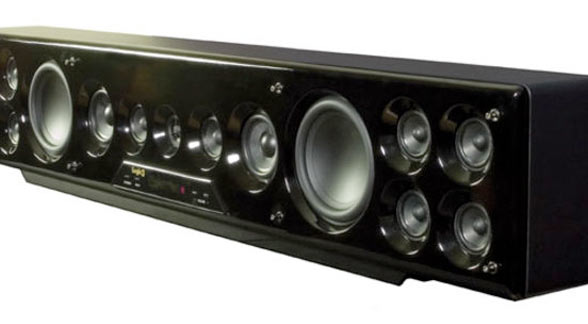Getting Surround Right
Multichannel audio has to be experienced to be appreciated and it’s best heard through a good surround sound system. For audiophiles this usually means a home theater system instead of a dedicated multichannel room because that’s where the surround system is in the house. As we discussed the other day, it could also be an automobile. Car systems can do a pretty good job of delivering high quality 5.1 surround sound. After all, the designers of the systems know where the listening positions are.
Home theater systems can be expensive. The cost of 5 reasonable speakers, a good sub and A/V Receiver can be thousands or many thousands of dollars. And the components are not necessarily optimized for music delivery. Take the center speaker, for example. The typical center speaker is oriented horizontally rather than vertically. Of course, this is to avoid interfering with the television monitor but does it change the sound quality? Yes. Even if the center speaker has the same drivers as the left and right front speakers, the shift from vertical to horizontal changes the sound. You can test this for yourself. Most A/V Receivers can generate noise (usually pink noise) and selectively send it to the individual speakers in your setup. If you listen at a moderate volume the tonal characteristics of identical speakers should sound the same and those that are different will sound different. That’s a problem for a music-focused system.
Then there are the left and right surround speakers. If you go to a big box store or even use the services of a custom electronics installer, there is a strong chance that they will try to sell you dipole speakers for the surrounds. Don’t get sucked in to their pitch. Dipoles might be fine for motion picture soundtracks but they are completely unsuitable for music. On the other hand a direct radiating speaker can work just fine for movies AND be perfect for music. A dipole has a much wider spread than a signal axis speaker. There are two (thus the “di” prefix) sets of speakers (usually out of phase with each other) to simply spread ambiance type sound in the back of your listening environment…good for movie soundtracks but not good for music.
The ideal multichannel setup uses 5 identical speakers in a properly configured ITU 5.1 array. I’ve provided the locations of the speakers in a past post but it critical that the left and right surround be off axis at about 110-120 degrees and no more! There are other companies that endorse speaker arrangements that vary from the ITU standard but I’ve been completely satisfied by the results I get by mixing into a traditional 5.1 setup. I know Chesky advocated for a single speaker located on the ceiling and MDG in Germany have pushed for 2+2+2 for optimal results. Are people really going to get behind surround music if they have to change the physical setup of their rooms every time they switch from a movie to music? I don’t think so.
So step one in getting a reasonable 5.1 surround music room set up is buying 5 identical speakers. I think one of the primary reasons why surround music is a tough sell is because music lovers get pretty tweaky about their stereo speakers. Lots of research, time and money has been spent on getting stereo to sound right and now someone is asking you to invest in 3 more speakers of equal quality. Not gonna happen.
Of course, you can go the “home theater in a box” route. I actually have a Bose system in my office (I’m not embarrassed to say I own a Bose system…although it was given to me by the company). You could outfit your room with a cost effect system for less than $2000 and get pretty good sound. I did this for my daughter in San Francisco…and the results are pretty decent.
And then there’s the Smyth “Room Realizer” option. More on that later.


Nice post Mark. I agree about the centre speaker problem resulting from its horizontal driver arrangement. One good engineering approach to this issue is the use of vertical tweeter and midrange drivers with bass drivers to the sides.
An example is shown here: http://www.krix.com.au/epicentrix.html?SID=ebfifgbhtdvtuaeg9sp7116m11. This speaker is well suited to audio — (and I don’t mind saying I use it as an example because they are made a few km’s from where I live and I know the designers). 🙂